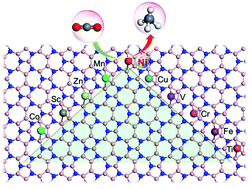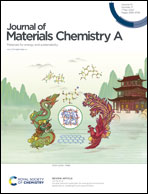Design of 3d transition metal anchored B5N3 catalysts for electrochemical CO2 reduction to methane†
Abstract
Carbon dioxide (CO2) reduction to value-added fuels and chemicals by making full use of the electricity generated from clean energy is promising to address environmental pollution and the energy crisis. However, the poor product selectivity at a low overpotential significantly hinders the large-scale use of catalysts. Herein, we provide a design guideline toward CO2 selective reduction to methane (CH4) by analyzing ten single-atom 3d transition metals (Sc, Ti, V, Cr, Mn, Fe, Co, Ni, Cu, and Zn) anchored on a B5N3 monolayer and screening favorable CO2 electrocatalytic reduction pathways using spin-polarized density functional theory calculations with van der Waals corrections. Our results show that single-atom Ni anchored at the B5N3 monolayer (Ni@B5N3) exhibits good stability and electrical conductivity due to the hybrid orbitals at the Fermi level caused by doping. This designed catalyst possesses a high theoretical CH4 selectivity and a considerably low limiting-potential (−0.21 V vs. reversible hydrogen electrode) for CO2 electrocatalytic reduction to methane, in which the conversion of *CH3 to *CH4 is the potential-determining step. This study not only broadens the potential applications of B5N3 but also motivates experimental efforts to use single-atom catalysts for converting CO2 to value-added hydrocarbons.

- This article is part of the themed collection: 2022 Journal of Materials Chemistry A Most Popular Articles


 Please wait while we load your content...
Please wait while we load your content...